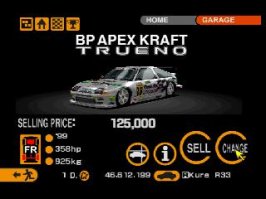Jetboys427
Shedloads of grip, but not quite enough power......89/100
Next up: Plymouth Superbird
Yes! A heavy heavy car at 3,840 pounds...it's probably the heaviest muscle car for sure. In real life it got 7 miles to the gallon in the city and 11 mpg on the highways, but was made in the era back when a gallon of gas only cost 60¢. The Superbird was Plymouth's less famous twin to the Dodge Daytona, and both cars featured nose cones and wings that were supposed to provide aerodynamic support but in reality didn't do much. It's wild that Mopar actually sold these beasts with their wings in real-life. I actually saw a Daytona once when I was travelling thru North Carolina.
The engine is the best part (as my tests confirm below) but the rest of the car blows 'till you start modifying it....the suspension, tires, brakes, even the transmission could use some help since it's geared for fast ¼ mile runs and will peak out past the engine's redline during most any race.
Since GT2 is not a very demanding game, you can get away with racing a Superbird in a surprising amount of races even though it handles poorly even with suspension upgrades. The NA tuned races, Seattle, Apricot Hill, Grand Valley enduros, Muscle Car events, 2 of the FR races, Grand Touring Cup, and 2 of the Pure Sports car races, and Super Touring are all up for grabs if you're brave enough.
With simple upgrades (port & polish, balancing, computer) the 426 cubic-inch Hemi jumps from 430 bhp to 467 bhp@5,100 rpm with 515 ft-lbs. of torque @4,100 rpm and features a 6,600 rpm redline. When racing a Superbird, use a full-modifyable manual transmission. Since the power drops off severely above the mid-5,000 range (with any power upgrades) you should shift gears well before the redline to get maximum power.
Keep in mind that I don't pop the clutch for my tests, which makes them slightly slower than what you can get, but this also gives us a clear picture of the engine's power from idle to redline.
0-60 mph: 5.078 seconds
0-100 mph: 11.474
¼ MIle: 13.579@110 mph
1 KM: 24.740@134 mph
Test Track: 1:51.920
Top Speed at redline:
1st: 54 mph
2nd: 73 mph
3rd: 97 mph
4th: 137.71 mph@7,000 rpms
Pros:
1. Speed & lots of power. Power upgrades available.
2. A piece of motor history. Gran Turismo actually did a good job with the detailing on this one and it doesn't look all weird and stuff.
3. Relatively affordable power. If you divide the price of the car ($41,850) by it's tested power (430 hp) you get $98.32 per horse.
4. Power to weight ratio is just 8.9.
5. Hemi engine sounds phat!
Cons:
1. Heavy!
2. Poor handling. Real-life 'bird had F60x15" tires...fine for straight-line runs...poor for circuit racing.
3. You'll need to be somewhat rich to afford all the parts you'll need to get this car manageable, unless you're really a Gran Turismo Guru.
4. Engine redlines too early in 4th gear during most races unless you get a racing transmission.
5. Despite its aerodynamic looks, the 'bird is actually poor in racing situations. Most of its stability comes from all that weight.
6. The oversteer we all expect...it's the understeer that's really awful, though!
Scale of 1 to 10: I give the Superbird a 4 in terms of it's usefulness.
Next car: 1996 Nissan 240SX Q's



 . Has anyone seen a pic of the '05 models? They look nice. Anyways, stock this thing ain't real speedy. Just look at that 1000 meter time
. Has anyone seen a pic of the '05 models? They look nice. Anyways, stock this thing ain't real speedy. Just look at that 1000 meter time  . Even a Vitz is faster than that. With all modifications except TCS (it doesn't need it
. Even a Vitz is faster than that. With all modifications except TCS (it doesn't need it  .), it's faster, dare I say that it's spunky. It's not exactly fun to drive but with the Turbo it ain't that bad either. Racing mod looks good too. I'll give it 12/100 on GT terms.
.), it's faster, dare I say that it's spunky. It's not exactly fun to drive but with the Turbo it ain't that bad either. Racing mod looks good too. I'll give it 12/100 on GT terms. 
